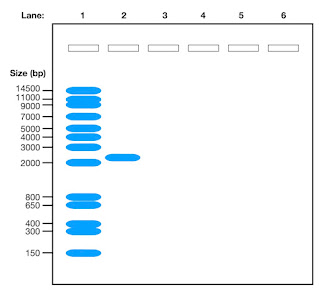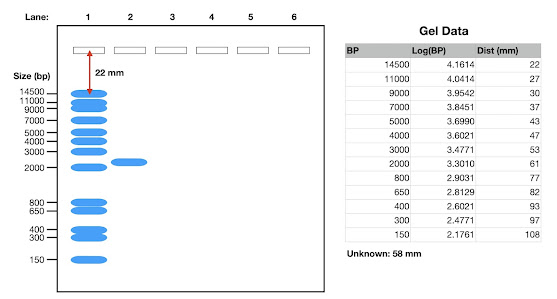How do scientists determine the size of DNA bands on an agarose gel? In this guide, I will walk you through the step-by-step process of calculating the size in base pairs of a DNA band on an agarose gel.
Introduction
When working in a lab and running an agarose gel, you may need to determine the size of the DNA fragment, and this information may be crucial for various biological research applications.
This approach is also described in the following video:
Setting Up the Experiment
Imagine you have loaded a DNA ladder with known sizes in one lane and your DNA sample with an unknown size in another lane of the gel and you get a result that looks like this when the gel has been run.
Before you can calculate the size of your DNA band, you must first label the gel and collect data to create a calibration curve.
Data Collection and Analysis
By measuring the distances the DNA bands in the ladder (see below) have moved and plotting the log values of their sizes against the distances travelled in millimetres (or you can do it in pixels), you can create a calibration curve. This curve will help you accurately determine the size of the DNA band in your unknown sample.
The image below shows the gel and the data table for the plot.
Calculating the Size of the DNA Band
After plotting the calibration curve (above) and identifying the distance your unknown band has travelled, you can use the curve to determine the size of the DNA band in base pairs. By following a simple formula involving logarithms, you can convert the log value to the actual size in base pairs.
Conclusion
Calculating the size of a DNA band on an agarose gel requires careful data collection, analysis, and interpretation. By following the steps outlined in this guide, you can confidently determine the size of DNA fragments in your samples.
If you would like to support my blogging efforts, then please feel free to buy me a coffee at https://www.buymeacoffee.com/drnickm
Additional Resources
- 📗 - Maths and Chemistry Refresher for Life and Biomedical Scientists
- 📗 - Catchup Chemistry (affiliate link to the book)
- 📗 - Catchup Maths and Stats (affiliate link to the book)
- 📗 - Maths and Chemistry Refresher for Life and Biomedical Scientists
- 📗 - Catchup Chemistry (affiliate link to the book)
- 📗 - Catchup Maths and Stats (affiliate link to the book)


